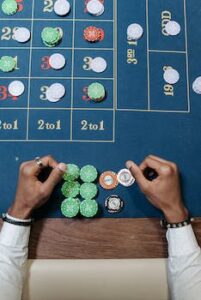“Cracking the Code: Your Comprehensive Guide to Understanding and Exploiting the Objective of Poker for Maximum Victory” is a comprehensive guide that aims to provide readers with a deep understanding of the objective of poker and how to exploit it for maximum success. This book delves into the intricacies of the game, offering valuable insights, strategies, and techniques to help players enhance their poker skills and increase their chances of winning. Whether you are a beginner looking to grasp the fundamentals or an experienced player seeking to refine your tactics, this guide is designed to equip you with the knowledge and tools necessary to crack the code of poker and achieve victory at the highest level.
The Fundamentals of Poker: Understanding the Objective and Rules
Poker is a game that has captivated players for centuries, with its blend of strategy, skill, and luck. Whether you’re a seasoned pro or a novice looking to learn the ropes, understanding the objective and rules of poker is crucial to your success at the table. In this comprehensive guide, we will delve into the fundamentals of poker, equipping you with the knowledge you need to exploit the game for maximum victory.
At its core, the objective of poker is simple: to win the pot, which is the collection of chips or money wagered by the players. This is achieved by either having the best hand at the showdown or by convincing your opponents to fold their hands before the showdown. To accomplish this, players must make strategic decisions based on the strength of their hand and the actions of their opponents.
To understand the rules of poker, it’s important to familiarize yourself with the different variants of the game. The most popular variant is Texas Hold’em, where each player is dealt two private cards and must make the best possible hand using a combination of their own cards and the community cards on the table. Other popular variants include Omaha, Seven-Card Stud, and Five-Card Draw, each with its own unique set of rules and strategies.
In poker, the game progresses through a series of betting rounds. The first round, known as the pre-flop, occurs before any community cards are dealt. Players must decide whether to fold, call the current bet, or raise the bet. This initial decision sets the tone for the rest of the hand, as players assess the strength of their hand and the potential of the community cards.
Once the pre-flop betting round is complete, the dealer reveals the flop, which consists of three community cards placed face-up on the table. This is followed by another round of betting, where players can choose to check, bet, call, raise, or fold based on the strength of their hand and the potential of the community cards.
After the flop betting round, the dealer reveals the turn, which is a fourth community card. This is followed by another round of betting, where players have the same options as before. Finally, the dealer reveals the river, which is the fifth and final community card. This is followed by the last round of betting, where players make their final decisions based on the strength of their hand and the potential of the community cards.
Once the betting is complete, the remaining players reveal their hands at the showdown. The player with the best hand, according to the hand rankings, wins the pot. In the event of a tie, the pot is split equally among the winners.
Understanding the objective and rules of poker is just the first step towards becoming a successful player. To truly exploit the game for maximum victory, players must develop their strategic thinking, reading their opponents, and mastering the art of bluffing. By honing these skills and continuously learning and adapting to the ever-changing dynamics of the game, players can elevate their poker game to new heights.
In conclusion, poker is a game that requires a deep understanding of its objective and rules. By grasping the fundamentals and familiarizing yourself with the different variants, you can embark on a journey towards becoming a formidable poker player. Remember, success in poker is not solely determined by luck, but by skill, strategy, and the ability to exploit the game to your advantage. So, gather your chips, sharpen your mind, and get ready to crack the code of poker for maximum victory.
Mastering Poker Strategy: Exploiting Weaknesses and Maximizing Opportunities
Cracking the Code: Your Comprehensive Guide to Understanding and Exploiting the Objective of Poker for Maximum Victory
At its core, the objective of poker is simple: to win chips. Whether you’re playing in a friendly home game or a high-stakes tournament, the goal remains the same. However, achieving this objective requires a deep understanding of the game’s mechanics and the ability to exploit weaknesses in your opponents’ play.
One key aspect of poker strategy is identifying and exploiting weaknesses. Every player has their own unique style and tendencies, and it’s crucial to pay attention and adapt your strategy accordingly. For example, if you notice that a player is overly aggressive, you can use their aggression against them by playing more defensively and trapping them into making mistakes. On the other hand, if a player is too passive, you can take advantage of their reluctance to bet by bluffing more frequently.
Another important aspect of exploiting weaknesses is understanding the concept of position. In poker, your position at the table can greatly influence your decision-making. Being in a late position allows you to gather more information about your opponents’ hands before making your own move. This knowledge can be used to exploit their weaknesses and make more informed decisions. Conversely, being in an early position requires more caution, as you have less information to work with.
Maximizing opportunities is another crucial element of poker strategy. This involves capitalizing on favorable situations and making the most out of your strong hands. One way to do this is by value betting, which means betting a sizeable amount when you have a strong hand to extract maximum value from your opponents. However, it’s important to be mindful of your opponents’ tendencies and adjust your bet sizing accordingly. If you’re playing against a more cautious player, a smaller bet may be more effective in enticing them to call.
Bluffing is another powerful tool for maximizing opportunities in poker. By bluffing, you can make your opponents believe that you have a stronger hand than you actually do, forcing them to fold and winning the pot without a showdown. However, bluffing should be used sparingly and strategically. It’s important to consider the context of the game, your opponents’ tendencies, and the strength of your own hand before attempting a bluff.
In conclusion, mastering poker strategy is a complex endeavor that requires a deep understanding of the game’s objective and the ability to exploit weaknesses while maximizing opportunities. By paying attention to your opponents’ tendencies, understanding the concept of position, and making strategic decisions based on the strength of your hand, you can increase your chances of achieving maximum victory. Remember, poker is not just a game of luck, but a battle of wits where skill and strategy reign supreme. So, study the game, practice your skills, and get ready to crack the code of poker.
Analyzing Poker Hands: Decoding the Code for Optimal Decision Making
One of the key aspects of poker is analyzing the hands that are dealt to you. Each hand presents a unique set of possibilities and challenges, and it is up to the player to decipher the code and make the optimal decision. This process requires a combination of mathematical calculations, psychological insight, and a deep understanding of the game.
When analyzing a poker hand, the first step is to assess the strength of your own hand. This involves evaluating the value of your cards and considering the potential for improvement. A pair of aces, for example, is a strong starting hand, while a hand with no pairs or high-ranking cards may require more caution.
The next step is to consider the actions of your opponents. Are they betting aggressively or playing conservatively? This can provide valuable information about the strength of their hands. If an opponent is betting heavily, it may indicate a strong hand, while a player who is checking or betting small amounts may be bluffing or holding a weaker hand.
Transitional phrase: Moving on to the next aspect of analyzing poker hands…
Another important factor to consider is the position at the table. The later your position, the more information you have about the actions of your opponents. This can give you a significant advantage in decision making. For example, if you are the last to act, you have the opportunity to observe the actions of all other players before making your move.
In addition to these factors, it is crucial to consider the overall context of the game. Are you playing in a tournament or a cash game? Is the table tight or loose? These factors can influence your decision-making process. In a tournament, for instance, the objective may be to accumulate chips and survive until the final table, while in a cash game, the focus may be on maximizing profits.
Transitional phrase: Now let’s explore some strategies for exploiting the objective of poker…
One strategy for exploiting the objective of poker is to play aggressively when you have a strong hand and to bluff when you have a weak hand. By betting or raising aggressively, you can put pressure on your opponents and force them to make difficult decisions. This can lead to them folding their hands, allowing you to win the pot without a showdown.
Another strategy is to use deception to your advantage. By varying your betting patterns and disguising the strength of your hand, you can confuse your opponents and make it difficult for them to read your intentions. This can give you a significant edge in the game.
In conclusion, analyzing poker hands is a crucial skill for any serious poker player. By evaluating the strength of your own hand, considering the actions of your opponents, and taking into account the overall context of the game, you can make informed decisions that maximize your chances of success. By employing strategies such as aggressive play and deception, you can exploit the objective of poker and emerge as a victorious player. So, the next time you sit down at the poker table, remember to crack the code and play to win.
Psychological Warfare in Poker: Exploiting Mind Games for Victory
Poker is not just a game of cards; it is a battle of wits, a psychological warfare where players strategically exploit mind games to gain an advantage over their opponents. Understanding and utilizing these psychological tactics can be the key to achieving maximum victory at the poker table.
One of the most effective mind games in poker is the art of bluffing. Bluffing is the act of making your opponents believe that you have a stronger hand than you actually do. It is a powerful tool that can force your opponents to fold their hands, even when they have a better hand than yours. However, bluffing requires careful execution and a deep understanding of your opponents’ playing styles.
To successfully bluff, you must first establish a tight and solid image at the table. This means playing only strong hands and avoiding unnecessary risks. By doing so, you create an illusion that you only play when you have a strong hand. Once you have established this image, you can then strategically bluff by betting aggressively when you have a weak hand. This puts pressure on your opponents, making them doubt the strength of their own hands and potentially forcing them to fold.
Another psychological tactic in poker is the use of intimidation. Intimidation involves projecting a confident and dominant demeanor at the table, which can make your opponents feel uneasy and unsure of their own decisions. This can be achieved through body language, such as maintaining eye contact, sitting upright, and controlling your facial expressions. By exuding confidence, you can make your opponents doubt their own abilities and make mistakes.
Furthermore, paying close attention to your opponents’ behavior and reactions can provide valuable insights into their hand strength. This is known as “reading” your opponents. By observing their body language, facial expressions, and betting patterns, you can gain clues about the strength of their hand. For example, a player who suddenly becomes tense or avoids eye contact may be bluffing, while a player who confidently raises the bet may have a strong hand. By reading your opponents, you can make more informed decisions and exploit their weaknesses.
However, it is important to remember that psychological warfare in poker is a double-edged sword. While you can use these tactics to your advantage, your opponents can also use them against you. Therefore, it is crucial to maintain a balanced approach and not become predictable. Varying your playing style, mixing up your strategies, and adapting to different opponents can help you stay one step ahead.
In conclusion, understanding and exploiting the psychological aspects of poker can greatly enhance your chances of victory. Bluffing, intimidation, and reading your opponents are powerful tools that can give you an edge at the poker table. However, it is important to use these tactics wisely and adapt to different situations. By mastering the art of psychological warfare in poker, you can crack the code and achieve maximum victory.
Advanced Techniques in Poker: Cracking the Code for Maximum Success
To truly understand and exploit the objective of poker, one must first grasp the fundamental concept of the game: to win chips. While this may seem obvious, many players overlook the importance of this objective and become too focused on individual hands or specific strategies. By keeping the ultimate goal in mind, players can make more informed decisions and adapt their strategies accordingly.
One key aspect of cracking the code in poker is understanding the concept of expected value (EV). EV is a mathematical calculation that determines the average amount of chips a player can expect to win or lose over the long run. By analyzing the EV of different actions, players can make more profitable decisions. For example, if a player has a hand with a positive EV, they should bet or raise, as this will maximize their expected winnings.
Another crucial element in cracking the code of poker is mastering the art of reading opponents. Poker is a game of incomplete information, where players must rely on their ability to interpret their opponents’ actions and make educated guesses about their holdings. By observing betting patterns, body language, and other subtle cues, skilled players can gain valuable insights into their opponents’ strategies and adjust their own accordingly.
Bluffing is another advanced technique that can be used to exploit the objective of poker. Bluffing involves making a bet or raise with a weak hand in order to deceive opponents into folding stronger hands. Successful bluffing requires a deep understanding of the game, as well as the ability to accurately assess the likelihood of opponents folding. By carefully selecting the right moments to bluff, players can gain a significant advantage and increase their chances of victory.
In addition to understanding the objective of poker and employing advanced techniques, it is crucial for players to manage their bankroll effectively. Bankroll management involves setting limits on the amount of money a player is willing to risk and sticking to those limits. By practicing responsible bankroll management, players can minimize their losses and ensure they have enough chips to continue playing and capitalize on profitable opportunities.
Lastly, cracking the code of poker requires constant learning and improvement. The game is constantly evolving, with new strategies and techniques emerging all the time. By studying books, articles, and videos, as well as analyzing one’s own gameplay, players can stay ahead of the curve and continue to refine their skills.
In conclusion, cracking the code of poker is a multifaceted endeavor that requires a deep understanding of the game, mastery of advanced techniques, and a commitment to continuous learning. By keeping the objective of winning chips in mind, understanding expected value, reading opponents, bluffing strategically, managing bankroll effectively, and staying up to date with the latest strategies, players can maximize their chances of success. So, grab your deck of cards, sharpen your skills, and get ready to crack the code of poker for maximum victory. “Cracking the Code: Your Comprehensive Guide to Understanding and Exploiting the Objective of Poker for Maximum Victory” is a valuable resource for individuals looking to enhance their understanding and skills in the game of poker. The book provides comprehensive insights into the objective of poker and offers strategies for exploiting it to achieve maximum success. Whether you are a beginner or an experienced player, this guide can help you improve your gameplay and increase your chances of winning in poker.




